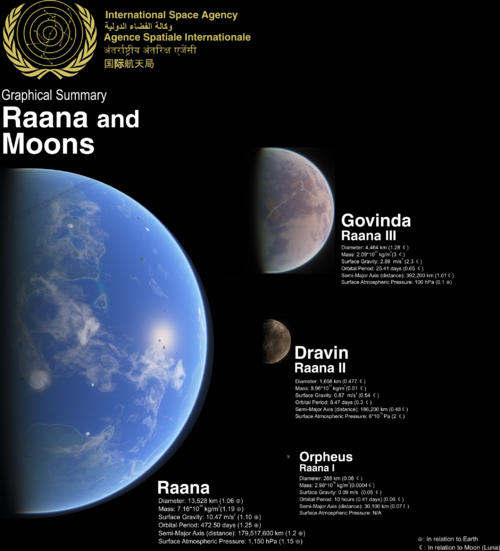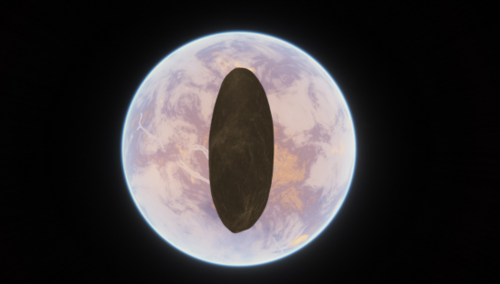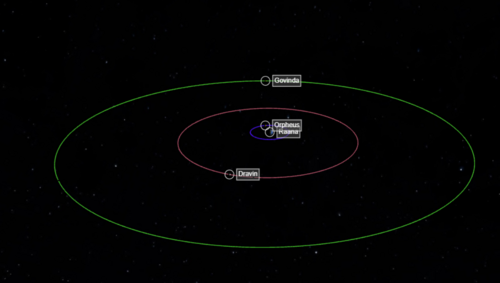The Moons of Raana: Difference between revisions
m fleshed out descriptions slightly |
|||
| (11 intermediate revisions by 2 users not shown) | |||
| Line 1: | Line 1: | ||
[[file:Raanamoons2.png|thumb|right|500px]] | |||
[[file:catseye.png|thumb|right|500px]] | |||
[[file:rotation.png|thumb|right|500px]] | |||
Raana is orbited by three celestial bodies, officially known as Raana-2, Raana-3 and Orpheus. Raana-2 and Raana-3 are two planetary bodies while Orpheus is a large asteroid caught in Raana's gravitational field. | Raana is orbited by three celestial bodies, officially known as Raana-2, Raana-3 and Orpheus. Raana-2 and Raana-3 are two planetary bodies while Orpheus is a large asteroid caught in Raana's gravitational field. | ||
==Raana-2== | ==Raana-2 (Dravin)== | ||
*'''Diameter:''' | *'''Diameter:''' 1,658 km. | ||
*'''Atmosphere:''' No. | *'''Atmosphere:''' No. | ||
*'''Distance to Raana:''' | *'''Distance to Raana:''' 186,200 km. | ||
*'''Other:''' Also known as Dravin. | *'''Other:''' Also known as '''Dravin'''. | ||
Raana-2 is a barren and lifeless planetoid orbiting Raana, of average size for the moon of a rocky planet. | |||
==Raana-3== | ==Raana-3 (Govinda)== | ||
*'''Diameter:''' | *'''Diameter:''' 4,464 km. | ||
*'''Atmosphere:''' Yes. | *'''Atmosphere:''' Yes. | ||
*'''Distance to Raana:''' | *'''Distance to Raana:''' 392,200 km. | ||
*'''Other:''' Also known as Govinda. | *'''Other:''' Also known as '''Govinda'''. | ||
Raana-3 is large enough to have sufficient gravity to retain a thin atmosphere, allowing it to harbor life. The moon is always covered in sand-colored clouds, making it look like it's draped in light-beige silk. | |||
The Gaius-expedition of 2245 documented several multicellular creatures and plants but was unable to find any signs of advanced lifeforms. Raana-3's wild and unpredictable storms obstructed later expeditions and the last orbiting scientific satellite malfunctioned just five years after [[The Severance]]. | The Gaius-expedition of 2245 documented several multicellular creatures and plants but was unable to find any signs of advanced lifeforms. Raana-3's wild and unpredictable storms obstructed later expeditions, and the last orbiting scientific satellite malfunctioned just five years after [[The Severance]]. | ||
==Orpheus== | ==Orpheus (Raana-I)== | ||
*'''Diameter:''' 144 km. | *'''Diameter:''' 144 km. | ||
*'''Distance to Raana:''' | *'''Distance to Raana:''' 30,100 km. | ||
*'''Other:''' Consists of burnt basalt. | *'''Other:''' Consists of burnt basalt. | ||
Orpheus is a large asteroid captured by the gravitational field of Raana and now orbiting the planet rather than its sun. | |||
==The Eye of | ==The Eye of Wisdom== | ||
The "Eye of Wisdom phenomenon", also known as The Harbinger, occurs once every eight years when Orpheus positions itself in front of Raana-3 during sunset, causing the planet to look like a giant cat's eye due to Orpheus' narrow shape and light-absorbing properties. | The "Eye of Wisdom phenomenon", also known as The Harbinger, occurs once every eight years when Orpheus positions itself in front of Raana-3 during sunset, causing the planet to look like a giant cat's eye due to Orpheus' narrow shape and light-absorbing properties. | ||
Latest revision as of 10:16, 27 October 2025



Raana is orbited by three celestial bodies, officially known as Raana-2, Raana-3 and Orpheus. Raana-2 and Raana-3 are two planetary bodies while Orpheus is a large asteroid caught in Raana's gravitational field.
Raana-2 (Dravin)
- Diameter: 1,658 km.
- Atmosphere: No.
- Distance to Raana: 186,200 km.
- Other: Also known as Dravin.
Raana-2 is a barren and lifeless planetoid orbiting Raana, of average size for the moon of a rocky planet.
Raana-3 (Govinda)
- Diameter: 4,464 km.
- Atmosphere: Yes.
- Distance to Raana: 392,200 km.
- Other: Also known as Govinda.
Raana-3 is large enough to have sufficient gravity to retain a thin atmosphere, allowing it to harbor life. The moon is always covered in sand-colored clouds, making it look like it's draped in light-beige silk.
The Gaius-expedition of 2245 documented several multicellular creatures and plants but was unable to find any signs of advanced lifeforms. Raana-3's wild and unpredictable storms obstructed later expeditions, and the last orbiting scientific satellite malfunctioned just five years after The Severance.
Orpheus (Raana-I)
- Diameter: 144 km.
- Distance to Raana: 30,100 km.
- Other: Consists of burnt basalt.
Orpheus is a large asteroid captured by the gravitational field of Raana and now orbiting the planet rather than its sun.
The Eye of Wisdom
The "Eye of Wisdom phenomenon", also known as The Harbinger, occurs once every eight years when Orpheus positions itself in front of Raana-3 during sunset, causing the planet to look like a giant cat's eye due to Orpheus' narrow shape and light-absorbing properties.
How the eye positions itself is studied in detail by the CTM as it's said to tell about future events and the state of humanity on Raana.
Govinda and Dravin are the focus of The Church of The Two Moons.